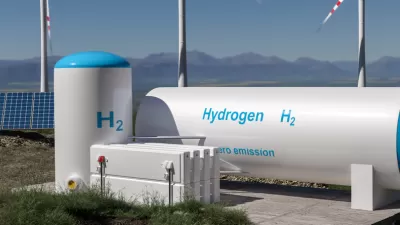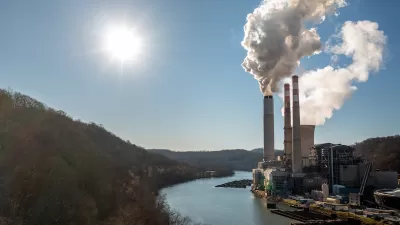Carbon capture and storage has long been associated with coal-burning power plants. Calpine Corp. hopes to apply the controversial technology to existing natural gas power plants, beginning with a pilot project to start this month in the Bay Area.

For the last seven years, electricity generation has been the second largest source of greenhouse gas emissions in the U.S. [Planetizen: A New Era in the U.S.: More Carbon Emissions from Transportation Than Utilities, June 14, 2016].
A major reason for the drop in greenhouse gas emissions from the power sector has been the shuttering of coal plants largely due to replacement by cleaner-burning natural gas powered plants. A July 2016 post, “Controversial Clean Coal Plant is Subject of Investigative Journalism,” notes that while coal and natural gas each supplied about a third of U.S. power in 2015, because coal is so much more carbon-intensive than gas, it produced 71 percent of carbon emissions from electric power generated in the U.S. that year.
Fast forward seven years to 2022: Natural gas provided nearly 40% of the nation's power with coal just under half of that, according to the U.S. Department of Energy's Energy Information Administration (EIA). Even with the substantially lower share provided by coal power, those plants continue to emit significantly more CO2 than natural gas, though the gas powered plants' share of power plant CO2 emissions grew to 43% last year, according to EIA.
Carbon capture and storage
Carbon capture and storage (CCS), an expensive and controversial technology which captures and stores the carbon emissions from the burning of fuels, has been applied almost exclusively to coal since President George W. Bush announced the FutureGen project in 2003. In fact, it was initially referred to as 'clean coal technology.'
- A Postmortem on the FutureGen 'Clean Coal' Project, February 13, 2015
- Back from the Dead—FutureGen Clean Coal Project Approved, January 17, 2014
However, with the Biden administration's proposal in May to “set limits for new gas-fired combustion turbines, existing coal, oil and gas-fired steam generating units, and certain existing gas-fired combustion turbines,” according to the Environmental Protection Agency, utility companies will need to consider applying the technology to lesser-polluting gas plants as well.
“The government is not mandating the use of equipment to capture carbon emissions before they leave the smokestack, a nascent and expensive technology,” wrote Coral Davenport, climate and environment reporter for The New York Times on May 11, on the new standards and guidelines.
Rather, it is setting caps on pollution rates, which power plant operators would have to meet. They could do that by using a different technology or, in the case of gas plants, switching to a fuel source like green hydrogen, which does not emit carbon.
Calpine projects
Calpine Corporation, the nation's largest generator of electricity from natural gas and geothermal resources, “unveiled its first-ever carbon capture demonstration pilot last week at its Pittsburg [California] Los Medanos Energy Center power plant,” reported Judith Prieve for The Mercury News on July 15.
The pilot project will test new technology that could capture nearly all of the plant’s carbon emissions, reducing greenhouse emissions – and doing so in a cost-effective way.
Unlike existing carbon capture technology, Calpine will add a new feature developed by ION Clean Energy of Colorado, added Prieve.
The test project’s innovative technology...will make reducing greenhouse gas at existing gas-fired power plants more practical and cost-efficient, company officials say. Under the process, carbon dioxide-rich gas moves into an absorption tower where a liquid solvent will bind with it, allowing the gas to be cleaned and released and the carbon piped out for safe storage a half-mile down into the Earth.
The project is temporary, meant to test the new technology.
The process would capture as much as 95% of the carbon emitted at the 678-megawatt plant, he said. It would capture about 10 tons of carbon dioxide per day for approximately 13 to 18 months under the 1-megawatt test, which will begin soon, company officials said.
“I personally have been working on this problem for 20 years, boy am I excited to see this happening in the field,” Roger Aines, a senior advisor on carbon dioxide removal for the U.S. Department of Energy, told CBS News Bay Area on July 14.
Ari Plachta, climate reporter for The Sacramento Bee, reported on Aug. 5 in the source article for this post, that the $25 million pilot project at the Pittsburg plant in Contra Costa County will begin this month and will be the basis for a $1 billion project at Calpine's Sutter Energy Center about 40 miles north of Sacramento.
If Calpine’s pilot goes well and the company cinches millions in state and federal grants, it will break ground for the nation’s first commercial CCS project on a gas-fired electricity plant on a grassy field in the rural outskirts of Yuba City.
NET Power's demonstration project
The Sutter Energy Center would be the first application of CCS to an existing natural gas power plant, but it will not be the first time that carbon capture will be applied to natural gas power plants. A 50 MW natural gas demonstrate project in La Porte (Harris County), Texas built by NET Power, a North Carolina “clean energy technology company," began operation in November 2021.
The plant uses a nontraditional form of carbon management known as the Allam-Fetvedt cycle that eliminates CO2 emissions. “The achievement marks a major milestone for the potentially revolutionary technology for which several commercial power plants are already under development,” reported Sonal Patel for POWER Magazine on Nov. 18, 2021.
Planetizen's two posts on the unconventional carbon capture technology:
- Can 'Clean Coal Technology' Be Cost-Effective for Natural Gas? April 14, 2017
- Meet the 'Zero-Carbon' Natural Gas Power Plant, June 2, 2018
On Nov. 7, 2022, NET Power announced “its plan to develop and build the world’s first utility-scale natural gas-fired power plant with near-zero atmospheric emissions” near Odessa, Texas.
The project fully integrates power production with transportation and underground sequestration of carbon dioxide. The new plant will be built near Occidental’s Permian Basin operations. The plant is expected to be online in 2026.
The plant does not have units to capture air emissions of CO2 and other harmful substances. Its only air emission is water, said Ron DeGregorio, CEO of NET Power.
Federal funds available
In September 2022, the U.S. Department of Energy announced that $4.9 billion from the Infrastructure Investment and Jobs Act was available to ‘manage and store carbon pollution,' one of two new 'clean energy' programs funded by the IIJA.
Hat tip to Streetsblog California's Morning Roundup, Aug. 8.
FULL STORY: Can gas plants be climate friendly? Yuba City carbon capture project wants to be the nation’s first

Planetizen Federal Action Tracker
A weekly monitor of how Trump’s orders and actions are impacting planners and planning in America.

Congressman Proposes Bill to Rename DC Metro “Trump Train”
The Make Autorail Great Again Act would withhold federal funding to the system until the Washington Metropolitan Area Transit Authority (WMATA), rebrands as the Washington Metropolitan Authority for Greater Access (WMAGA).

The Simple Legislative Tool Transforming Vacant Downtowns
In California, Michigan and Georgia, an easy win is bringing dollars — and delight — back to city centers.

In These Cities, Most New Housing is Under 441 Square Feet
With loosened restrictions on “micro-housing,” tiny units now make up as much as 66% of newly constructed housing.

Albuquerque’s Microtransit: A Planner’s Answer to Food Access Gaps
New microtransit vans in Albuquerque aim to close food access gaps by linking low-income areas to grocery stores, cutting travel times by 30 percent and offering planners a scalable model for equity-focused transit.

This City Will Pay You to Meet Your Neighbors
A North Kansas City grant program offers up to $400 for residents to throw neighborhood block parties.
Urban Design for Planners 1: Software Tools
This six-course series explores essential urban design concepts using open source software and equips planners with the tools they need to participate fully in the urban design process.
Planning for Universal Design
Learn the tools for implementing Universal Design in planning regulations.
Smith Gee Studio
City of Charlotte
City of Camden Redevelopment Agency
City of Astoria
Transportation Research & Education Center (TREC) at Portland State University
US High Speed Rail Association
City of Camden Redevelopment Agency
Municipality of Princeton (NJ)




























